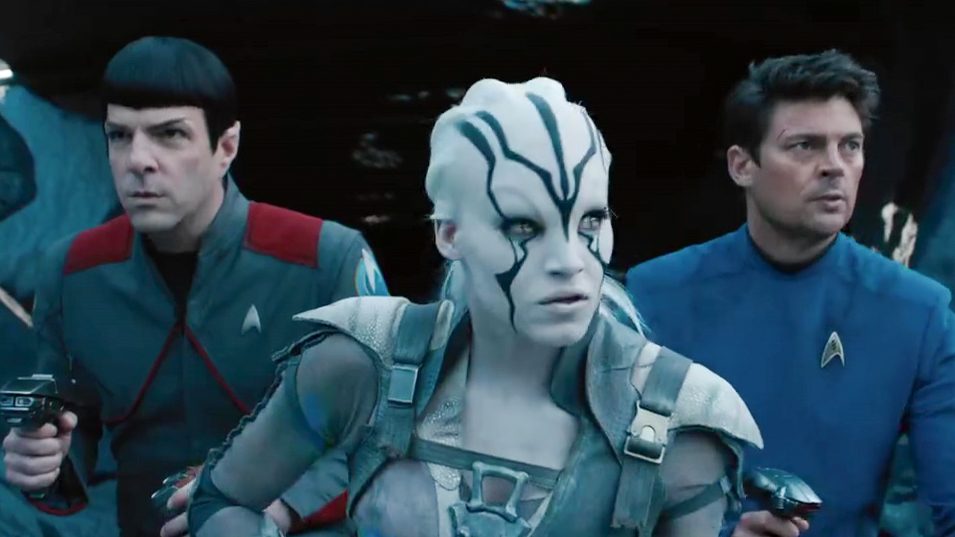
“To boldly go where no man has gone before.”
That is exactly what Justin Lin did not do for his first outing as director of the rebooted Star Trek franchise.
His Star TrekBeyond doesn’t really take any risks. There are no surprises, no cliffhangers, and very little bigger-than-the-movie messages. However, in spite of all the seeming lack of ambition, the film remains to be delightful amid its stubborn reliance on tried and tested tactics.
Whimsical

The film opens with a scene that is reminiscent of the oddball episodes that starred William Shatner and Leonard Nimoy. In it, Captain James Kirk, played again by Chris Pine, negotiates with ferocious looking alien creatures who seem to be a cross between Simba and any of the creatures from Guillermo del Toro’s Pan’s Labyrinth (2006).
There is a hilarious punchline to the introduction, one that gives a comforting smallness to what initially looks to be a grandiose pageant of top-notch digital effects. It paints the overall feel of the film, which is to be utterly whimsical even in the face of a likely apocalypse.
{source}<iframe width="100%" height="360" src="https://www.youtube.com/embed/XRVD32rnzOw" frameborder="0" allowfullscreen></iframe>{/source}
When JJ Abrams took over the franchise, he did to Gene Roddenberry’s beloved space adventure series what Hollywood thought should be done to aging material that has nostalgic value. He turned Star Trek into a spectacle of sights and sounds, with angst-ridden characters shouldering contemporary dilemmas that range from the personal to the political.
Abrams’ Star Trek (2009) and Into Darkness (2013) both benefited and suffered from ambitions to flip the franchise into something alarmingly different from the repetitive planet-hopping adventures that its television-bound predecessors were.
Abrams’ films proved that given a modern context and his trademark lens flare-filled aesthetics, the series can evolve into something more immense than the simplistic but wonder-filled romps that led Shatner’s Kirk and Nimoy’s Spock to pop culture immortality.
Gloss and flair

On the downside, Abrams’ films felt quite distant and serious. They were struggling under the needless weight of the artificial relevance that they sought to achieve. They felt more like the troubled and troubling sci-fi blockbusters that allegorizes contemporary society than the jubilant shows that proved to be timeless.
Thankfully, Star Trek Beyond, written by Simon Pegg (who also plays Montgomery Scott, engineer of the USS Enterprise) and Doug Yung, brings the franchise back to Earth, or more accurately, to the vast space of unexplored planets and undiscovered alien races.

It does so too, without much of the dark and drab baggage that Abrams’ films are all too eager to carry. Lin’s film is a lot of fun, bringing together all of the crew of the Enterprise in an exploit that is predictably straightforward, just like how it was when they were still on television – just with all of the gloss and flair of a big-budgeted Hollywood event.
The movie tells the story of the USS Enterprise crew being marooned and separated in an uncharted planet where a mysterious and scheming warlord-like space beastie (Idris Elba) resides.
Lin, perhaps most famous for infusing the latter sequels of The Fast and Furious with much-needed mirth and audacity, uses this to frame a series of eye-popping action sequences and showcases of camaraderie.
Lin’s proficiency shows. Beyond works exactly like how any of his The Fast and Furious films work – fast, furious, and funny.
Strengths and weaknesses

Beyond works well because it knows its strengths, and acknowledges its weaknesses, skirting around them like they didn’t exist.
The film is most exhilarating when its camera is relentlessly kinetic, navigating through constantly exploding hallways while characters are engaging in phaser gun battles or fisticuffs. It is most beautiful when it reveals the extent of the action it portrayed in detail from space, showcasing the immensity of the destruction. It is most buoyant when it relishes in the often humorous and oddly emotional interactions between the characters.

Beyond is oblivious to all the plotholes, the sci-fi conveniences it uses to forward its plot, and all the corny nonsense about unity and togetherness which feels more like an afterthought than a rallying theme. It simply keeps on propelling forward, in a way that makes you forget that a lot of the story doesn’t make any sense or logic.
By the film’s end, it has accomplished its mission, leaving less of a real impact that Abrams’ films provided – but more of the excitement.– Rappler.com
 Francis Joseph Cruz litigates for a living and writes about cinema for fun. The first Filipino movie he saw in the theaters was Carlo J. Caparas’ 'Tirad Pass.' Since then, he’s been on a mission to find better memories with Philippine cinema.
Francis Joseph Cruz litigates for a living and writes about cinema for fun. The first Filipino movie he saw in the theaters was Carlo J. Caparas’ 'Tirad Pass.' Since then, he’s been on a mission to find better memories with Philippine cinema.